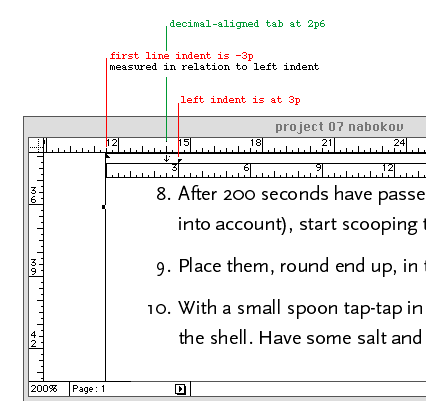
The purpose of this project is to give you practice using tab stops and paragraph indents to format tables and numbered lists. The project has two parts.
Find or invent material for a table that has at least three columns and at least five rows. Enter this material in a single text box, using tab characters to establish it as a table.
Some ideas for tables include:
Select all the rows that need the same formatting, and then use Style/Tabs... to place the correct tab markers in the tab ruler. Remember to use just one tab character between columns in your table; and place tabs for each column rather than relying on the default half-inch tab settings.

Your table should demonstrate the use of center-aligned tabs, decimal-aligned tabs, right-aligned tabs, or some combination of these. A table that requires at least two of these different kinds of tab markers will be most instructive. Please avoid a table that has every column left-aligned.
Do not use rules (lines) between the rows and columns of your first table. Instead, see how close the material can be placed and still read clearly. If you want to adjust the spacing of the tab markers, be sure to select all the rows before making adjustments.
Copy your table and paste another version in a different location (or on another page). In the copy, experiment with adding horizontal rules between the rows or vertical rules between the columns, whichever makes more sense. To make horizontal rules, you can use the Format/Rules... feature. To make vertical rules, use the Orthogonal Line tool and the Item/Step and Repeat feature to make copies of the line.
Quark has a Table feature for making a table as a matrix of cells, each of which can have its own content (inset, margins, alignment). If you want to try making a table that way as a third option, do so. You can adjust the dimensions of the cells by dragging the handles and rules, and you can specify the color and thickness of the rules independently, or use None as a color for no rules.
When you have formatted your tables, you may wish to add frames around them, or place them in a document whose trim size you specify.
Invent a numbered list with than 10 steps. Your list could be a how-to procedure. Your procedure can be something serious or something whimsical.
The numbers should be aligned on their decimal points using a decimal-aligned tab or right-algned tab. To make sure that steps that take up more than one line wrap so that the text does not intrude under the numbers, you will use what is called a hanging indent.

To make a hanging indent for a numbered list, do this:
When a numbered list aligns on its decimal points and is designed to allow two-digit numbers, it is called clearing for 10 -- that is, allowing for the possibility that the list numbers will go beyond one digit.
Make sure that your text includes several steps or items that take more than one line of text, to see that it is wrapping correctly to the left-indent marker. Use a narrow text box size to achieve this if you have short steps.
If you wish, you can use a character style sheet to format the step numbers using a different font, weight, or size than the running text of the steps.
Save your table work as lastname-7a and your numbered list as lastname-7b. Make sure you hand in both your Quark files, as well as PDF exports of both files.
Weinmann and Lourekas. QuarkXPress 6 for Windows & Macintosh.
Chapter 8: Tables and Tabs
Optional: pp. 137-156 on text table feature.
Required: pp. 157-160 on setting tabs.